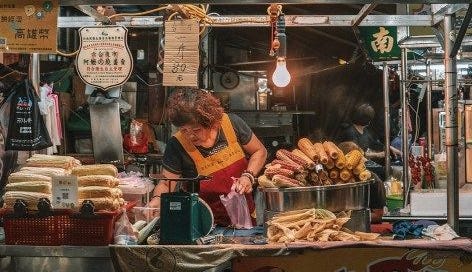99-ranch & culture
Every aisle feels so incredibly familiar and yet so distant. The aroma of freshly baked steamed buns fills me with excitement. I walk up and down each aisle, scanning each product just to see if I recognize it. A pre-packaged boba kit reminds me of the time my brother and I would treat milk tea boba like water; an unhealthy obsession that was normalized amongst children in Taiwan. Another aisle takes me back to my grandmother, who used to make fresh dumplings every weekend. I can picture her scooping the meat filling with a spoon, shaping the dumpling evenly, and dropping it in a pot of boiling water. My eyes dart to the snack section and my body becomes possessed by my 5-year-old self. Suddenly, I’m sitting on the bus with my grandmother, snacking on dried squid and chugging down water to chase the saltiness.
At 99-ranch, I find myself searching for familiar foods: Takoyaki, green onion pancakes, Portuguese egg tarts, pan fried pork buns, and more. The products I find are frozen, but the image on the packaging takes me back to the place. It’s 11pm and I’m strolling down the Shanghai night markets, holding my mom’s hand, careful not to lose her in a crowd full of locals and tourists. “Takoyaki, Takoyaki” I yell to my mom. She never failed to buy me Takoyaki, unlike the other street food my mother only allowed me to eat with my eyes. I wait in the long line behind some college students, my eyes only watching the people making the Takoyaki. The sight is engrained so deeply into my mind I can still describe the entire process today. The batter is released from this weirdly shaped dispenser, it fills up the round holes on the pan. Then after a few minutes, green onion, octopus, and other vegetables are added. They begin to flip the Takoyaki with a sharp tool, adding more filling until it becomes a complete ball. I watch the Takoyaki crisp as my mouth waters. I always ordered the regular 8-count, which is topped with traditional sauce, Japanese mayo, seaweed flakes, and bonito flakes. My mom and I find someplace to sit, sometimes in a 7-eleven or an 85 degrees bakery. My tongue burns because I never wait long enough before biting into a steamy, filled, Takoyaki. I always save the last one for my mom. Now, I stare at the pre-packaged microwavable Takoyaki, which I never buy because it does my childhood a great injustice.
Like staying in on a cold rainy day, shopping at Asian supermarkets brings back a sense of comfort and familiarity. The nostalgia feels like a strong tide that consumes me. Although my regular grocery trips feature Trader Joe’s or Costco, once in a while I yearn to visit 99-ranch or H-mart. It has become a vessel to my roots and childhood. By simply roaming the aisles, walls of memories cave in, completely overtaking me.
On some days, eating a traditional dish is much more satiating than my normal go-to meals. Once in a while, I am overtaken by the desire to connect with my culture. In a way, I feel as if I have lost a small part of myself by perfectly integrating into a westernized lifestyle. I can no longer name some of my favorite Taiwanese dishes or hold a conversation in Mandarin like I once could.
In my opinion, food is the most important part of culture. It connects all of us. It has the wonderful ability of transporting us to a unique time, place, or memory. One bite of a green onion pancake takes me back to the streets of Taiwan, where the air is humid, and the 7-Eleven’s are superior.
Perhaps that is why I enjoy 99-ranch so much. Because the sight of medicinal mushrooms, bento boxes, fresh red bean buns, and ramen samples makes me feel reassured. I know these smells. I know these foods. I know what these people are saying. I have not lost my culture.


